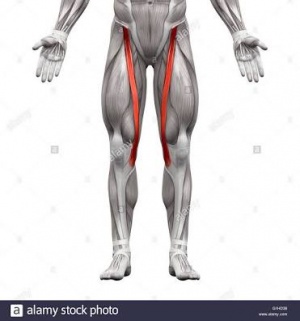Sartorius: Difference between revisions
Rotimi Alao (talk | contribs) (Iii) |
Rotimi Alao (talk | contribs) (You) |
||
| Line 1: | Line 1: | ||
== '''Description''' == | == '''Description''' == | ||
The sartorius muscle is a thin, long, superficial muscle in the anterior compartment of the thigh.<ref name=":0">Moore, Keith L.; Dalley, Arthur F.; Agur, A. M. R. (2013). Clinically Oriented Anatomy. Lippincott Williams & Wilkins. pp. 545–546. <nowiki>ISBN 9781451119459</nowiki>.</ref> It runs down the length of the thigh, runs over 2 joints- hip and knee joints <ref name=":1">Dziedzic D, Bogacka U, Ciszek B. (2014) Anatomy of sartorius muscle. Folia Morphol (Warsz). 73(3):359-62. doi: 10.5603/FM.2014.0037.</ref> and is the longest muscle in the human body.<ref name=":0" /> An exceptional length of this muscle often exceeds 50cm.<ref>Clavert P, Cognet JM, Baley S, Stussi D, Prevost P, Babin SR, Simon P, Kahn JL (2008). Anatomical basis for distal sartorius muscle flap for reconstructive surgery below the knee. Anatomical study and case report. J Plastic, Reconstr Aesthetic Surg, 61: 50–54.</ref> In such long muscles not all muscle fibres run through the whole length of the muscle belly.<ref name=":1" /> It is estimated that at the most 30–50% of fibres run from tendon to tendon.<ref name=":1" /> The rest of them end intrafascicularly.<ref name=":1" /> The length of a single fibre is estimated at 35–45 cm.<ref>Klein Horsman M, Koopman H (2007) Morphological muscle and joint parameters for musculoskeletal modelling of the lower extremity. Clin Biomech, 22: 239–247.</ref> | The sartorius muscle is a thin, long, superficial muscle in the anterior compartment of the thigh.<ref name=":0">Moore, Keith L.; Dalley, Arthur F.; Agur, A. M. R. (2013). Clinically Oriented Anatomy. Lippincott Williams & Wilkins. pp. 545–546. <nowiki>ISBN 9781451119459</nowiki>.</ref> It runs down the length of the thigh, runs over 2 joints- hip and knee joints <ref name=":1">Dziedzic D, Bogacka U, Ciszek B. (2014) Anatomy of sartorius muscle. Folia Morphol (Warsz). 73(3):359-62. doi: 10.5603/FM.2014.0037.</ref> and is the longest muscle in the human body.<ref name=":0" /> An exceptional length of this muscle often exceeds 50cm.<ref>Clavert P, Cognet JM, Baley S, Stussi D, Prevost P, Babin SR, Simon P, Kahn JL (2008). Anatomical basis for distal sartorius muscle flap for reconstructive surgery below the knee. Anatomical study and case report. J Plastic, Reconstr Aesthetic Surg, 61: 50–54.</ref> In such long muscles not all muscle fibres run through the whole length of the muscle belly.<ref name=":1" /> It is estimated that at the most 30–50% of fibres run from tendon to tendon.<ref name=":1" /> The rest of them end intrafascicularly.<ref name=":1" /> The length of a single fibre is estimated at 35–45 cm.<ref>Klein Horsman M, Koopman H (2007) Morphological muscle and joint parameters for musculoskeletal modelling of the lower extremity. Clin Biomech, 22: 239–247.</ref> | ||
[[File:Sartorius .jpg|center|thumb| | |||
[[File:Sartorius .jpg|center|thumb|Sartorius <ref><nowiki>http://www.innerbody.com/image_musfov/musc20-new.html</nowiki></ref>]] | |||
Revision as of 23:51, 11 March 2018
Description[edit | edit source]
The sartorius muscle is a thin, long, superficial muscle in the anterior compartment of the thigh.[1] It runs down the length of the thigh, runs over 2 joints- hip and knee joints [2] and is the longest muscle in the human body.[1] An exceptional length of this muscle often exceeds 50cm.[3] In such long muscles not all muscle fibres run through the whole length of the muscle belly.[2] It is estimated that at the most 30–50% of fibres run from tendon to tendon.[2] The rest of them end intrafascicularly.[2] The length of a single fibre is estimated at 35–45 cm.[4]

- ↑ 1.0 1.1 Moore, Keith L.; Dalley, Arthur F.; Agur, A. M. R. (2013). Clinically Oriented Anatomy. Lippincott Williams & Wilkins. pp. 545–546. ISBN 9781451119459.
- ↑ 2.0 2.1 2.2 2.3 Dziedzic D, Bogacka U, Ciszek B. (2014) Anatomy of sartorius muscle. Folia Morphol (Warsz). 73(3):359-62. doi: 10.5603/FM.2014.0037.
- ↑ Clavert P, Cognet JM, Baley S, Stussi D, Prevost P, Babin SR, Simon P, Kahn JL (2008). Anatomical basis for distal sartorius muscle flap for reconstructive surgery below the knee. Anatomical study and case report. J Plastic, Reconstr Aesthetic Surg, 61: 50–54.
- ↑ Klein Horsman M, Koopman H (2007) Morphological muscle and joint parameters for musculoskeletal modelling of the lower extremity. Clin Biomech, 22: 239–247.
- ↑ http://www.innerbody.com/image_musfov/musc20-new.html






